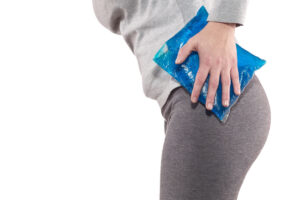In the article “Why Does Bowling Hurt My Hip?”, we check out the common issue faced by many bowling enthusiasts – hip pain.
Bowling is an enjoyable activity, but the repetitive motions involved can take a toll on our bodies.
This article aims to uncover the various reasons behind hip discomfort while bowling, exploring potential causes such as improper technique, overuse injuries, and underlying medical conditions.
Understanding the factors contributing to hip pain can help you prevent and address these issues, allowing you to continue enjoying the game pain-free.
Why Does Bowling Hurt My Hip?
Bowling can hurt your hip due to the repetitive and dynamic movements involved in the sport. The mechanics of the bowling approach, swing, and release place considerable stress on the hip joints and surrounding muscles, leading to overuse injuries and strain. Additionally, improper technique and the use of equipment that does not suit your strength and skill level can exacerbate hip pain while bowling.
Understanding the Mechanics of Bowling and its Impact on the Hips
Understanding the mechanics of bowling and its impact on the hips is significant in addressing the issue of hip pain among bowlers.
Bowling involves a series of complex movements that can put significant strain on the hips.
The biomechanics of a bowling approach, swing, and release require coordinated movements that heavily rely on the lower body, including the hips.
During the approach, a bowler takes several steps to build momentum and generate power.
The hips play a pivotal role in weight transfer and balance during this phase, which can lead to repetitive stress on the hip joints.
As the bowler swings the bowling ball backward and forward, hip rotation is essential for generating the necessary speed and revs on the ball.
Additionally, the follow-through phase involves continued hip engagement and stability, which completes the delivery. When these movements are repeated frequently during bowling sessions, it can lead to overuse injuries and strain on the hip muscles and joints.
The impact of bowling on the hips can vary based on a bowler’s age and fitness level.
Younger bowlers may be more resilient to these repetitive stresses, but over time, the cumulative effect can still take a toll on their hips.
Older bowlers or those with pre-existing hip conditions may be more susceptible to hip pain and injuries.
Moreover, a bowler’s overall fitness and conditioning can influence how well their body withstands the demands of bowling.
Bowlers with stronger hip and lower body muscles, along with proper technique, may experience fewer issues compared to those with weaker muscles or improper mechanics.
Understanding the mechanics and its potential impact on the hips is essential for bowlers of all ages and skill levels to make informed decisions about their training, technique, and preventive measures to maintain hip health and enjoy bowling for years to come.
Common Causes of Hip Pain in Bowlers
Hip pain in bowlers can result from various factors, ranging from technique-related issues to overuse injuries and underlying medical conditions.
Understanding these common causes is essential for identifying and addressing the root of the problem. Some of the primary causes of hip pain in bowlers include:
1. Improper Bowling Technique and Body Mechanics: Incorrect bowling form can put undue stress on the hips.
For example, if a bowler doesn’t execute the approach, swing, or release properly, it may lead to improper weight distribution and excessive strain on one hip, causing pain and discomfort.
2. Overuse Injuries and Repetitive Strain: Bowling involves repetitive movements, and regularly subjecting the hip joints and surrounding muscles to the same motions can lead to overuse injuries.
Tendonitis, bursitis, and muscle strains are common overuse injuries that can cause hip pain in bowlers.
3. Pre-existing Musculoskeletal Conditions: Bowlers with pre-existing hip conditions, such as hip arthritis, labral tears, or hip impingement, may experience exacerbated symptoms due to the repetitive stress of bowling. These conditions can lead to chronic hip pain and may require medical attention.
4. Bowling Equipment: The type of bowling ball used and the condition of the bowling shoes can also contribute to hip pain.
Bowling balls that are too heavy or have improper weight distribution can strain the hips during the swing and release.
Ill-fitted or worn-out bowling shoes may affect stability and alignment, leading to hip discomfort.
The Role of Bowling Equipment in Hip Pain

The role of bowling equipment can significantly impact hip pain in bowlers.
The type and condition of bowling equipment, particularly bowling balls and shoes, can influence the stress placed on the hips during the game.
Here’s how bowling equipment can play a role in hip pain:
1. Bowling Balls and Weight Distribution: The weight of the bowling ball and its distribution can affect the amount of force required to swing and release it.
Using a ball that is too heavy for a bowler’s strength can lead to excessive strain on the hips and lower back during the swing phase.
Similarly, improper weight distribution in the ball can affect the bowler’s balance and alignment, potentially contributing to hip discomfort and injury.
2. Bowling Shoes and Support: Properly fitted bowling shoes are essential for maintaining stability and balance during the approach and delivery.
Ill-fitted shoes can lead to uneven weight distribution, which may put additional stress on one hip or leg.
Additionally, worn-out or unsupportive bowling shoes can impact the bowler’s posture and alignment, potentially leading to hip pain over time.
3. Gripping and Release Technique: The way a bowler grips and releases the bowling ball can also influence hip strain.
An incorrect grip or release technique can cause unnecessary tension in the hand, arm, and shoulder, leading to compensatory movements in the hips and potentially resulting in hip discomfort.
Preventive Measures: Tips for Avoiding Hip Pain While Bowling
Preventing hip pain while bowling involves a combination of proper technique, physical conditioning, and self-care practices.
Here are some preventive measures and tips to avoid hip pain and injuries on the bowling alley:
1. Correct Bowling Technique: Ensure that you are using proper bowling form and mechanics.
Work with a coach or experienced bowler to refine your approach, swing, and release. A sound technique will help reduce unnecessary strain on the hips and lower back.
2. Warm-Up Routine: Always perform a thorough warm-up before bowling.
Dynamic stretching and light exercises can help prepare the muscles and joints for the repetitive motions involved in bowling.
3. Strengthening Exercises: Incorporate exercises that target the muscles around the hips, such as hip flexors, glutes, and core muscles. Strengthening these areas can provide better support and stability during bowling.
4. Flexibility Training: Regularly stretch the hip muscles to maintain flexibility. This can improve hip range of motion and reduce the risk of injuries.
5. Limit Bowling Sessions: Avoid overdoing it with frequent and prolonged bowling sessions.
Allow sufficient rest and recovery time between games or practice sessions to prevent overuse injuries.
6. Listen to Your Body: Pay attention to any signs of discomfort or pain in your hips. If you experience persistent or worsening pain, take a break and seek medical evaluation if needed.
7. Proper Bowling Shoes and Equipment: Ensure your bowling shoes fit well and provide adequate support. Use a bowling ball with an appropriate weight and proper grip to reduce unnecessary strain on the hips.
8. Cross-Training: Engage in other physical activities to improve overall fitness and reduce the risk of overuse injuries specific to bowling.
9. Ice and Heat Therapy: After bowling, consider applying ice to the hips for about 15-20 minutes to reduce inflammation. Additionally, heat therapy before bowling can help relax muscles and improve blood flow.
10. Rest and Recovery: Get enough rest and sleep to allow your body to heal and rejuvenate between bowling sessions.
By incorporating these preventive measures into your bowling routine, you can significantly reduce the risk of hip pain and injuries, ensuring a more enjoyable and sustainable bowling experience. Remember to listen to your body and seek professional medical advice if you experience persistent or severe hip pain.
Seeking Professional Help: When to Consult a Doctor or Physical Therapist
Consulting a doctor or physical therapist is essential when experiencing persistent or severe hip pain that interferes with daily activities or affects your bowling performance.
Here are some situations when you should consider seeking professional help:
1. Chronic or Worsening Pain: If you have been experiencing hip pain for an extended period, or if the pain is getting worse despite rest and self-care measures, it’s time to consult a healthcare professional.
2. Pain at Rest: If you are experiencing hip pain even when you are not bowling or engaging in physical activities, it may indicate an underlying issue that requires medical attention.
3. Limited Range of Motion: If you notice a decrease in your hip’s range of motion, such as difficulty in bending, lifting, or rotating the hip, it could be a sign of a more significant problem that needs evaluation.
4. Swelling or Inflammation: If your hip appears swollen, red, or inflamed, it may indicate an injury or inflammation that requires medical assessment.
5. Numbness or Tingling: If you experience sensations of numbness, tingling, or weakness in the hip area or down the leg, it could be related to nerve compression or other neurological issues.
6. Difficulty Bearing Weight: If you find it challenging to put weight on one or both hips, it suggests a potential injury that needs prompt attention.
7. Previous Hip Conditions: If you have a history of hip injuries or pre-existing hip conditions, it’s important to monitor any changes in your symptoms and seek professional advice if needed.
8. Impact on Bowling Performance: If hip pain is significantly affecting your bowling technique, consistency, or scores, consulting a physical therapist can help identify biomechanical issues and implement corrective exercises.
When consulting a healthcare professional, be prepared to provide information about the nature of your hip pain, its onset, and any activities or movements that exacerbate or alleviate the pain.
They will conduct a thorough examination, which may include physical tests, imaging, and other diagnostic procedures, to identify the underlying cause of the hip pain.
Based on the findings, the doctor or physical therapist can recommend appropriate treatment, rehabilitation exercises, and lifestyle modifications to address the issue and promote hip health.
Remember, early intervention can prevent further complications and support your long-term well-being on and off the bowling alley.
Rehabilitation and Recovery: Treating Hip Injuries Related to Bowling

Rehabilitation and recovery are major steps in treating hip injuries related to bowling.
Depending on the nature and severity of the injury, the recovery process may vary.
Here are some common strategies used to treat hip injuries in bowlers:
1. Rest and Immobilization: In the case of acute injuries, such as muscle strains or minor tears, rest is essential to allow the hip to heal.
Immobilization through the use of a brace or crutches may be recommended to reduce strain on the injured hip.
2. Physical Therapy: Working with a physical therapist is instrumental in rehabilitating hip injuries.
They will design a personalized treatment plan that includes targeted exercises to strengthen the hip muscles, improve flexibility, and promote proper mechanics during bowling movements.
3. Ice and Heat Therapy: Applying ice to the injured hip can help reduce inflammation and alleviate pain.
Heat therapy may be used before physical therapy sessions to relax the muscles and enhance blood flow.
4. Pain Management: Over-the-counter pain medications or prescription medications may be prescribed to manage pain and inflammation during the recovery process.
5. Modalities: Therapeutic modalities such as ultrasound or electrical stimulation may be used in physical therapy to aid in pain relief and tissue healing.
6. Gradual Return to Bowling: Once the hip starts to heal, a gradual return to bowling may be recommended. It’s essential to listen to your body and avoid pushing yourself too hard too soon.
7. Technique Analysis: Working with a bowling coach or physical therapist to analyze and improve your bowling technique can help prevent future hip injuries and ensure proper body mechanics.
8. Core Strengthening: Strengthening the core muscles is crucial for hip stability and overall bowling performance. Incorporate exercises that target the abdominal and lower back muscles.
9. Flexibility Training: Regular stretching of the hip muscles can enhance flexibility and reduce the risk of future injuries.
10. Avoiding Overuse: Be mindful of your bowling frequency and take sufficient rest between sessions to prevent overuse injuries.
It’s imperative to follow the treatment plan prescribed by your healthcare professional diligently.
Avoid returning to bowling or any physical activity too soon, as this could lead to reinjury.
Be patient with the rehabilitation process, as full recovery may take time depending on the severity of the injury.
Always communicate any concerns or changes in symptoms to your healthcare provider to ensure the best possible outcome in your hip injury recovery journey.
Related post: Can Bowling Hurt Your Knee?
Lifestyle Adjustments for Long-term Hip Health in Bowlers
Maintaining long-term hip health is vital for bowlers to continue enjoying the sport without the risk of chronic pain or injuries.
Here are some lifestyle adjustments that can promote hip health and overall well-being for bowlers:
1. Cross-Training and Diversifying Activities: Engage in a variety of physical activities to prevent overuse injuries specific to bowling.
Cross-training, such as swimming, cycling, or yoga, can help improve overall fitness and reduce the repetitive stress on the hips.
2. Balanced Diet and Hydration: Adopt a balanced diet rich in nutrients that support joint health, such as omega-3 fatty acids, antioxidants, and vitamin D. Staying adequately hydrated is also essential for joint lubrication and overall body function.
3. Weight Management: Maintaining a healthy weight can reduce stress on the hips and lower body joints, decreasing the risk of joint problems and hip pain.
4. Proper Warm-up and Stretching: Always warm up before bowling and perform targeted stretching exercises for the hips and lower body to improve flexibility and reduce the risk of injuries.
5. Regular Physical Activity: Incorporate regular exercise into your routine to strengthen the muscles around the hips and improve joint stability.
6. Mind Your Technique: Continuously work on improving your bowling technique with the help of a coach or experienced bowler to avoid unnecessary strain on the hips.
7. Avoid Overexertion: Be mindful of your bowling frequency and take breaks to allow your body to recover and prevent overuse injuries.
8. Supportive Bowling Gear: Invest in proper bowling shoes that offer stability and cushioning to minimize the impact on the hips. Also, ensure that your bowling balls are well-suited to your strength and skill level.
9. Regular Check-ups: Schedule regular health check-ups with your doctor to monitor your overall health and address any hip-related concerns proactively.
10. Rest and Recovery: Allow sufficient time for rest and sleep to promote muscle repair and overall recovery after bowling sessions or physical activities.
By implementing these lifestyle adjustments, bowlers can proactively care for their hips and reduce the risk of hip pain and injuries, enabling them to continue enjoying the sport for years to come.
Taking a holistic approach to hip health includes not only on-lane practices but also maintaining overall physical fitness, proper nutrition, and self-awareness of one’s body.
Enjoying Bowling without Hip Pain – A Holistic Approach
Enjoying bowling without hip pain requires a holistic approach that encompasses various aspects of our physical and mental well-being.
The repetitive motions and demands of bowling can put significant stress on the hips, making it essential for bowlers to prioritize their hip health.
By understanding the mechanics of bowling and its impact on the hips, we gain valuable insights into potential causes of hip pain and can make necessary adjustments to our technique and equipment.
Preventive measures such as proper warm-ups, strengthening exercises, and balanced training regimes can help reduce the risk of hip injuries.
Additionally, seeking professional help when experiencing hip pain and working with physical therapists can aid in rehabilitation and recovery, ensuring a safe return to the sport.
Outside of the bowling alley, making lifestyle adjustments, including cross-training, maintaining a healthy diet, and managing weight, all contribute to long-term hip health and overall well-being.
By taking a proactive and attentive approach to our hip health, we can continue to indulge in the joy of bowling without being hindered by chronic pain or injuries.
Ultimately, the key lies in listening to our bodies, being mindful of our technique, and adopting a comprehensive approach to hip health that encompasses both on-lane practices and off-lane habits.
By doing so, bowlers can continue to embrace the thrill of the game, achieve optimal performance, and savor the camaraderie, all while safeguarding the health of their hips for years to come.
Related post: Can Bowling Cause Neck Pain?



